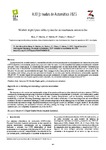Mostrar o rexistro simple do ítem
Modelo digital para definir y emular automatismos secuenciales
| dc.contributor.author | Illana, Sergio | |
| dc.contributor.author | Sánchez García, Alejandro | |
| dc.contributor.author | Estévez, Elisabet | |
| dc.contributor.author | Gómez Ortega, Juan | |
| dc.contributor.author | Gámez García, Javier | |
| dc.date.accessioned | 2023-10-09T15:05:28Z | |
| dc.date.available | 2023-10-09T15:05:28Z | |
| dc.date.issued | 2023 | |
| dc.identifier.citation | Illana, S., Sánchez, A., Estévez, E., Gómez, J., Gámez, J., 2023. Modelo digital para definir y emular automatismos secuenciales. XLIV Jornadas de Automática, 801-806. https://doi.org/10.17979/spudc.9788497498609.801 | es_ES |
| dc.identifier.isbn | 978-84-9749-860-9 | |
| dc.identifier.uri | http://hdl.handle.net/2183/33683 | |
| dc.description.abstract | [Resumen] La importancia de un diseño maduro y mantenible del software de automatización en los sistemas ciber-físicos de producción (CPPS) aumenta continuamente, ya que una proporción cada vez mayor de la funcionalidad del sistema se implementa mediante software. Como consecuencia, la complejidad del sistema se desplaza cada vez más hacia el lado del software. Características de calidad como la flexibilidad, la mantenibilidad y la extensibilidad, cuya importancia está aumentando en el contexto de la Industria 4.0, son cada vez más difíciles de lograr. Para conseguir dichos retos, se ha de partir de un diseño software sólido. En este sentido, este trabajo, propone una aproximación basada en modelos para diseñar automatismos secuenciales siguiendo GRAFCET. Un modelo digital del automatismo secuencial conteniendo el diseño software de automatización va a permitir testear el automatismo con la parte operativa real o emulada, de una manera totalmente independiente al PLC. | es_ES |
| dc.description.abstract | [Abstract] The importance of a mature and maintainable design of automation software in cyber-physical production systems (CPPS) is continuously increasing, as a growing proportion of system functionality is implemented by software. As a consequence, system complexity is increasingly shifting to the software side. Quality characteristics such as flexibility, maintainability and extensibility, which are becoming increasingly important in the context of Industry 4.0, are becoming more and more difficult to achieve. In order to meet these challenges, a solid software design has to be the starting point. In this sense, this paper proposes a model-based approach to design sequential automation following the GRAFCET standard. A digital model of the sequential automatism containing the automation software will allow testing the design of the automatism with the real or emulated operative part, in a completely independent way from the PLC. | es_ES |
| dc.language.iso | spa | es_ES |
| dc.publisher | Universidade da Coruña. Servizo de Publicacións | es_ES |
| dc.relation.uri | https://doi.org/10.17979/spudc.9788497498609.801 | es_ES |
| dc.rights | Attribution-NonCommercial-ShareAlike 4.0 lnternational (CC BY-NC-SA 4.0) https://creativecommons.org/licenses/by-ncsa/4.0/ | es_ES |
| dc.rights.uri | http://creativecommons.org/licenses/by-nc-sa/3.0/es/ | * |
| dc.subject | Industria 4.0 | es_ES |
| dc.subject | Modelo Digital gráfico | es_ES |
| dc.subject | Automatización industrial | es_ES |
| dc.subject | Industry 4.0 | es_ES |
| dc.subject | Digital Graphic Model | es_ES |
| dc.subject | Industrial Automation | es_ES |
| dc.title | Modelo digital para definir y emular automatismos secuenciales | es_ES |
| dc.title.alternative | Digital Model for Defining and Emulating Sequential Automatisms | es_ES |
| dc.type | info:eu-repo/semantics/conferenceObject | es_ES |
| dc.rights.access | info:eu-repo/semantics/openAccess | es_ES |
| UDC.startPage | 801 | es_ES |
| UDC.endPage | 806 | es_ES |
| dc.identifier.doi | https://doi.org/10.17979/spudc.9788497498609.801 | |
| UDC.conferenceTitle | XLIV Jornadas de Automática | es_ES |






